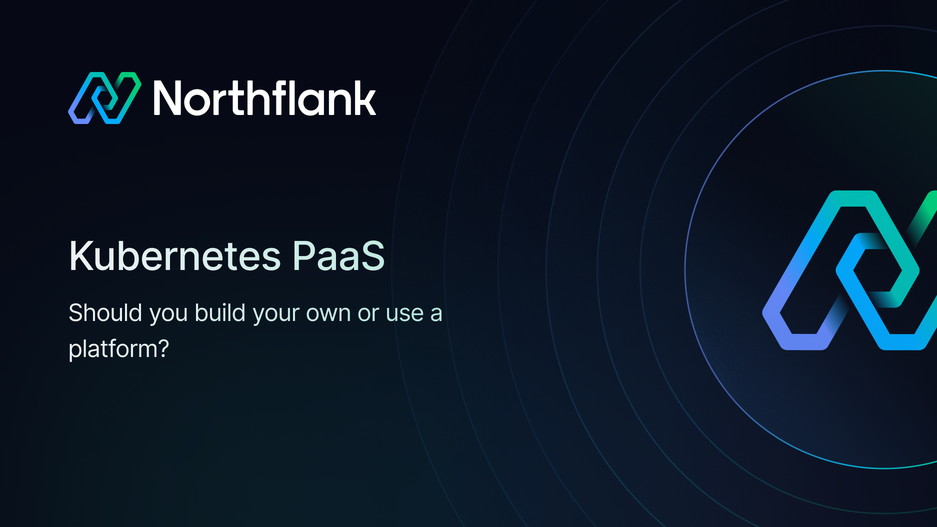

Kubernetes PaaS: should you build your own or use a platform?
Kubernetes was supposed to make container orchestration easier. Yet thousands of companies are now building another abstraction layer on top of it: a Kubernetes PaaS.
A Kubernetes PaaS is a platform layer that sits above Kubernetes, abstracting away its complexity and providing developers with a simpler deployment experience. Rather than writing YAML files and managing pods directly, developers can focus on shipping code.
This raises an important question: should you build your own PaaS layer on Kubernetes, or use an existing platform?
Building your own sounds great on paper because you get complete control, customization for your exact needs, and no vendor dependencies. However, the reality means committing 3 to 8+ engineers to maintaining infrastructure instead of building your product. It means chasing quarterly Kubernetes updates and debugging abstraction layers at 2 AM.
Meanwhile, platforms like Northflank offer production-grade alternatives without the operational burden. You get the same Kubernetes power and reliability, without the maintenance overhead.
This guide covers what a Kubernetes PaaS does, why teams need one, and how to choose the right approach for your organization.
A Kubernetes PaaS provides a developer-friendly abstraction layer on top of Kubernetes infrastructure. It handles the complexity of container orchestration while exposing simple interfaces for deployment, scaling, and management.
The key problems it solves include:
- Resource management (automatically handling CPU and memory limits)
- Service exposure (managing networking, load balancing, and ingress)
- Configuration (simplifying secrets, ConfigMaps, and environment variables)
- Self-service (letting developers deploy without waiting for ops teams)
- GitOps workflows (automating deployments from Git repositories).
No. Kubernetes is container orchestration infrastructure, closer to infrastructure-as-a-service (IaaS) that enables PaaS. While Kubernetes provides powerful primitives for running containers, it requires significant configuration and expertise to become developer-friendly.
Two types of Kubernetes PaaS exist. First, internal platforms are homegrown abstraction layers built by platform teams. Second, commercial platforms are third-party PaaS solutions built on Kubernetes infrastructure.
The question isn't about needing abstraction; most teams do. It's about building and maintaining it yourself versus using an existing solution.
If you're comparing Kubernetes PaaS options, you need to understand what makes them necessary and what approaches exist.
The challenge: Raw Kubernetes is too complex for most development teams. Managing YAML configs, resource limits, networking, and secrets requires specialized knowledge that slows down product development. Your developers want to ship features, not become Kubernetes experts.
The temptation: Building an internal PaaS seems like the natural answer. Large companies have tried this approach with massive engineering investments, only to discover the ongoing maintenance burden. Kubernetes releases quarterly, and every new feature means work for your platform team. Many of these companies have since pivoted toward different approaches that reduce this operational overhead.
The solution: Most teams skip the build vs buy debate entirely. They use platforms like Northflank that provide production-grade Kubernetes infrastructure with zero operational burden. You get simple Git-based deployments built on standard Kubernetes, which means simplicity without vendor lock-in. You get Kubernetes benefits (scalability, reliability, cloud-native architecture) without managing clusters or YAML files.
Your other options include building your own platform (if you have 8+ dedicated engineers) or using managed Kubernetes with additional tooling (if you have 3 to 5 platform engineers and need deep customization).
The rest of this article breaks down each approach in detail so you can make an informed decision for your team.
Despite Kubernetes' complexity, teams continue building custom PaaS layers on top of it. Understanding why reveals what problems you're trying to solve.
Your developers shouldn't need to understand pods, namespaces, ingress controllers, or YAML syntax just to deploy applications.
When every deployment requires platform team assistance, velocity suffers.
A PaaS layer promises to hide this complexity behind simple interfaces: push to Git, deployment happens automatically, and logs appear in a dashboard.
Setting CPU and memory limits sounds simple, but becomes complex in practice. Who owns creating these limits? Who sets them for production?
In the VM era, ops teams set fixed resources and occasionally threw more infrastructure at the problem. Kubernetes blurs the line between dev and ops, and wrong settings lead to either outages (limits too low) or cloud bill explosions (limits too high).
Without a PaaS layer, every team might deploy differently. Some use Helm, others use raw manifests, and some cobble together scripts. A PaaS layer promises standardization: one way to deploy, one way to manage services, one interface for all teams.
The math on building your own Kubernetes PaaS rarely works out. Even if you have the engineering talent, the opportunity cost is staggering.
Every change forces related changes in your PaaS layer. Your platform team faces an unending backlog of technical debt just to stay relevant.
Want to use the latest Kubernetes feature? You'll need to add it to your homegrown PaaS or wait months for your team to implement support.
While your competitors using platforms like Northflank get instant access to new capabilities, you're stuck maintaining infrastructure.
Requires typically 3 to 8+ engineers, depending on your organization's size. At an average fully-loaded cost of “$200K” per engineer, that's “$600K to $1.6M” annually just for salaries.
These engineers spend their time on continuous maintenance and updates, writing documentation and providing developer training, and debugging abstraction layers when issues arise.
What else could that team build for your business? Every hour spent maintaining your internal PaaS is an hour not spent on features that differentiate your product, optimizing your deployment pipeline, or improving observability.
For most teams, the economics are clear. A Kubernetes PaaS platform costs a fraction of maintaining your own, with none of the operational burden.
Unless you have multi-year Kubernetes expertise on staff, significant engineering resources to spare, and highly specialized requirements, building your own PaaS diverts focus from your core business.
Your choice depends on expertise, scale, and how much control you need. Think of these as a spectrum from maximum control (and maximum burden) to maximum velocity (with minimal overhead).
Platforms provide Git-to-deploy workflows without requiring Kubernetes knowledge. Your developers never touch YAML or kubectl.
You get deployments with preview environments, automatic resource optimization, built-in CI/CD, observability, databases, and team collaboration.
This suits startups, scale-ups, and any team that wants to move fast without sacrificing reliability.
Platforms like Northflank are built on standard Kubernetes, so your applications remain portable. You get enterprise-grade infrastructure without the enterprise-sized platform team.
Raw Kubernetes management suits large enterprises with specialized requirements and deep K8s expertise already in place. You get complete control but need 24/7 operations and 10+ engineers dedicated to platform work. This makes sense for companies where Kubernetes expertise is part of your competitive advantage, not just infrastructure.
Use managed Kubernetes (like EKS or GKE) and layer on tools like ArgoCD for GitOps workflows. You still handle developer training, CI/CD pipelines, observability stacks, and security configuration. This works for teams with 3 to 5+ platform engineers who need full Kubernetes control and have the capacity to maintain the tooling layer.
Tools like Porter, Cozystack, or CapRover let you run PaaS-like experiences on your own Kubernetes clusters. You get control over infrastructure but still handle maintenance, updates, and support yourself. This can work if you have specific compliance requirements, but you're trading cost savings for operational burden.
Northflank provides production-grade Kubernetes infrastructure without the operational complexity of building your own PaaS.
Northflank runs on Kubernetes but abstracts all complexity. You get the benefits (scalability, reliability, cloud-native architecture) without managing clusters, YAML files, or infrastructure decisions. Your applications run on Kubernetes infrastructure and remain portable if your needs change.
Northflank handles resource management with intelligent scaling based on usage patterns, resource recommendations and optimization, and cost controls with budget alerts. You don't need to guess at CPU and memory settings or risk outages from misconfiguration.
Unlike managed Kubernetes where you piece together multiple tools, Northflank provides everything in one platform. You get Git-connected builds that trigger automatically, managed databases (Postgres, MySQL, MongoDB, Redis) that provision in seconds, centralized logging and metrics, and secrets management with role-based access control.
Coming from Heroku? You'll find a similar Git-based workflow with more control. Migrating from DIY Kubernetes? You can reduce your platform team's burden while maintaining flexibility. Moving from traditional hosting? You get cloud-native architecture without requiring your team to become Kubernetes experts.
The question isn't about needing a Kubernetes PaaS. Most teams do. It's about who maintains it and at what cost.
| Approach | Example | Best for | Team size | What you get | What you maintain |
|---|---|---|---|---|---|
| PaaS platform (recommended) | Northflank | Fast-moving teams prioritizing velocity | Any size (ideal for less than 100 engineers) | Git-to-deploy, everything built-in | Nothing (focus on product) |
| Managed Kubernetes + tools | EKS + ArgoCD | Teams needing deep Kubernetes customization | 3-5+ platform engineers required | Kubernetes flexibility with reduced ops | Tooling layer, CI/CD, observability |
| Build your own | Internal platform | Highly specialized, unique requirements | 10+ platform engineers required | Complete control and customization | Everything (platform, tools, updates) |
The data tells a clear story. A PaaS platform gives you the best return on investment regardless of team size.
The question is: do you want your engineers building your product or maintaining Kubernetes infrastructure? You get Kubernetes power without the operational burden, and you can always move to more control later if your needs change.
Platforms like Northflank provide the fastest path to production for most teams. Your developers ship code faster, your platform team (if you have one) focuses on business priorities instead of infrastructure maintenance, and you maintain the flexibility to migrate if you eventually need it.
Get started with a free sandbox to deploy your first project, or book a demo if you have specific requirements and want to speak with an expert engineer.
Start by thinking about what your team needs today, not what you might need at 10x scale. Most companies never reach the scale where building their own platform makes sense. Those that do have the resources to migrate when the time comes. Don't let theoretical future needs prevent you from moving fast today.